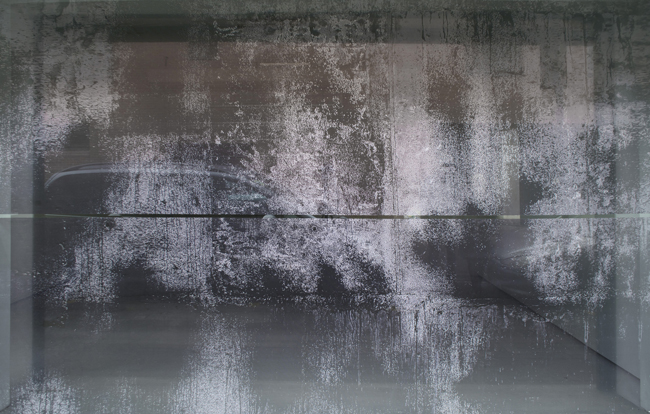Days later, millions of microscopic fragments of phosphor-coated lamp glass, deformed metal and wood chips are still lying within the tunnel, mixed with the gray crushed stone of the railway. Every now and then, instances of light reflect on the scattered copper debris. Then, the sound of the machines fades slowly as the train proceeds on the black-painted structure of the bridge.
In Bridge, a peripheral event becomes the inspiration for KERNEL to re-imagine a critical narrative on the contemporary geopolitical shifts that relate to the worldwide movements of matter, energy and people. Contemplating on the location of Greece as a historical node between East and West, Bridge is a reference to a newly built infrastructural project located in the suburban landscape of Athens: a transport railway bridge of Chinese and American interests that was mysteriously sabotaged on its inaugural journey.
Installed on the gallery’s glass storefront, a perforated vinyl print depicts a 1:1 scale fragment of a black monochrome graffiti that was painted recently throughout the bridge by a local graffiti crew that signs as “OFK”. Facing the street, this abstract particular of the illicit intervention on the structure’s concrete surface suggests an idiosyncratic documentation and a metaphoric geographical displacement between two remote and diverse kinds of public space. Spanning the gallery’s two floors, the sculptural installation titled Passage (Overground/Underground) constitutes a rearrangement of the existing fluorescent lamps of the exhibition space. On the ground floor, the lamps have been detached from their original positions and have been accumulated in order to compose a light wall made of metallic cable-trays. This two-dimensional stack is powered up from the power sockets of the lower floor, through an extension of the cable-tray structure that connects the two levels of the gallery. On the lower floor, this minimal infrastructure gets a more functional character by supporting the hanging of the last remaining pair of fluorescent lamps. Setting an atmospheric dim environment, the lamps are adjusted to light up directly the wall-mounted works that are installed in this space: two rectangular surfaces composed of compressed copper wiring that was sourced from scrap yards around the area of the bridge.
Global logistical operations of automated networks and non-human subjectivities intersect in Bridge with local parasitical economies and obscure processes of material resources recycling. By the means of spatial and material coding, KERNEL looks at the moments of friction and resistance within systems of paradoxical colonization, of real-time connectivity and maximized efficiency that perpetually suggested extreme scenarios for the organization
of human time and life.

